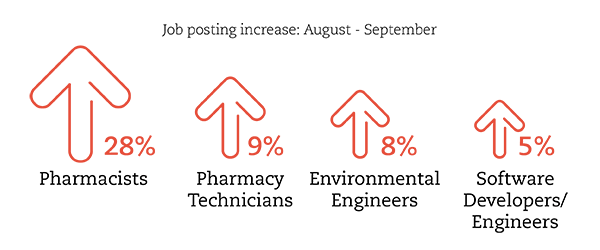Actalent's Economy and Labor Market Brief: September 2021
September's report has echoes of August: supply shortages and the COVID-19/Delta Variant continued to impact US economic and labor market growth with performance falling short of economists' predictions in several key metrics.
The National Landscape
- 194K jobs were gained in September, falling short of expectations largely due to notable losses in public education and government. Job gains in engineering and sciences, however, as well as the private sector, were strong.
- At 61.6%, September's labor force participation rate represents a loss over August. This rate remains largely unmoved from the summer's initial recovery and remains well below pre-pandemic participation rate levels (63.3% in February 2020).
- The overall unemployment rate was 4.8%, down from August's 5.2% rate. The unemployment rate for degreed workers fell further from 3.1% in August to 2.5% in September.
- 4.3M workers quit their job in August, a record high for quits and 24% higher than pre-pandemic levels.
Big Picture Implications
High demand, low supply. Businesses are looking to hire and grow, but the workers just aren't there. Whether due to a mix of burnout, childcare challenges, ability to live off savings or government benefits as many economists predict, workers have not yet returned to the labor force. The result is a slower than hoped recovery for many.
Law of demand. With talent in high demand and low supply, it's no surprise that average hourly rates increased by 4.6 percent compared to one year ago. And with inflation expected to outpace the 3 percent pay increases estimated by Conference Board, even the happiest employees might find it hard to pass up higher paying—or, more flexible— offers.
The Actalent Landscape
While overall job gains lagged expectations, gains in Actalent labor categories showed tremendous growth.
- Scientific Research + Development experienced an 8.6 percent increase in job gains over the previous year, with strong demand for clinical trial services and talent suggested.
- Architectural + Engineering Services experienced one of the largest gains in its history with a 5.2 percent increase over the previous year.
Unemployment rates continued to fall for Actalent labor categories in September:
- Software-Hardware + Mathematics: 1.7%
- Architecture + Engineering: 2.6%
- Sciences—Life, Physical, + Social: 2.0%
Demand for several Actalent positions is also way up, job postings showing significant increases between August and September:

Once again, the availability of workers to fill these positions is slim. Over the last three months, the ratio of unemployed workers to job openings in Actalent's core labor categories fell to 0.3. Translation: For every open position in engineering and sciences, there is 1/3 of a person available to fill it.
In a recent report, the National Foundation for American Policy (NFAP) estimated nearly 1.2 million unfilled computer-related job postings in September 2021, 500 thousand of which require software development skills.
And the news is catching up. The Wall Street Journal published a piece this week about the causes and effects of the tech shortage.

Behind the Scenes of the Shortages
- Shortages cause vulnerabilities. Vulnerabilities cause crises. We talk about the impact of the talent shortage on a business's ability to grow, but there's a more sinister threat to consider as well: crisis. Understaffed projects jeopardize security and quality—corners get cut, eyes avert, and before you know it, the Senate is holding a hearing. Talent shortages are difficult, but temporary if businesses find creative ways to address them. A hit to brand reputation, however, can be devastating—and, permanent.
- Is your company serious about growth and innovation in a shortage? Prove it. There are two trends emerging in businesses ability to attract and recruit high quality candidates in engineering and sciences: expedient hiring processes and competitive wages and benefits, including opportunities for hybrid and remote work. Given the low supply and high demand of talent in engineering + sciences, combined with elevated inflation, companies must find a way to make more competitive offers—better wages, creative benefits, greater flexibility, more personalized interactions—and they must make them faster.
- Flexibility matters. Many businesses are still navigating their remote-hybrid work options, while others have firmed up their policies—and locations. The New York Times released an Opinion piece this week, “Tech jobs are everywhere,” a nod to the lifting of geographical restrictions when it comes to talent. The article further drives the point home with a quote by Brookings senior fellow Mark Muro, who told the Wall Street Journal in July that companies embracing flexible work arrangements can “truly access lost Einstein's all across the country.” In the EY 2021 Work Reimagined Employee Survey released in June, more than 54 percent of the 16,000 employees surveyed from around the world said they'd consider leaving their job if not afforded some form of flexibility, with 9 out of 10 millennials indicating they'd definitely do so.
Bottom line: Companies must attract and retain qualified candidates with competitive offers, supportive and engaged managers, and opportunities to build their career—not only to grow the company, but to protect it.



